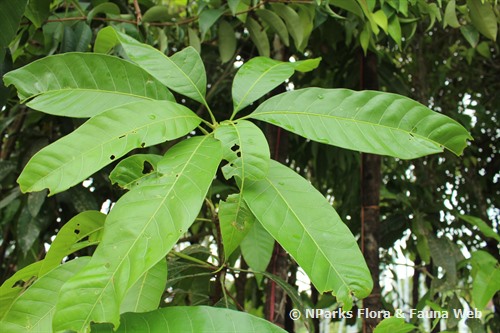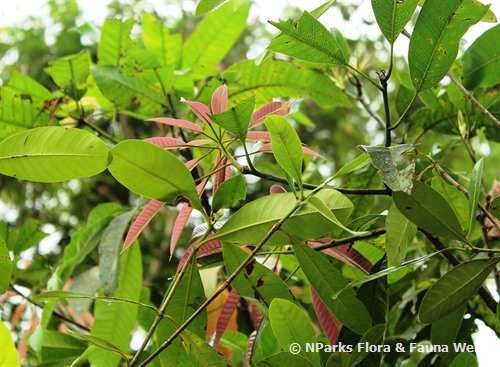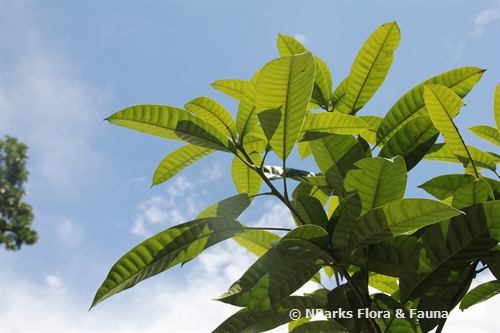
Name
Classifications and Characteristics
| Plant Division | Angiosperms (Flowering Seed Plants) (Dicotyledon) |
|---|---|
| Plant Growth Form | Tree (Medium (16m-30m)) |
| Lifespan (in Singapore) | Perennial |
Biogeography
| Native Distribution | Peninsular Malaysia |
|---|---|
| Native Habitat | Terrestrial |
| Preferred Climate Zone | Tropical |
Description and Ethnobotany
| Growth Form | It is a tree, up to 28 m tall, occasionally with small buttresses |
|---|---|
| Foliage | Leaves are leathery, oblong to lanceolate (12 – 30.5 cm long and 3.75 – 11 cm wide). There are 12 – 23 pairs of secondary veins which are distinct on both upper and lower surfaces, and densely reticulate. Leaf base is almost rounded, leaf tip is acuminate. Petiole is 1.5 – 3.5 cm long and prominently swollen at the base. |
| Flowers | Inflorescences is pyramidal (15 – 30 cm long), densely hairy and occurs at the terminal ends. Flowers are small, and comprises of 5-lobed calyx and 5 yellow to cream white coloured petals with 5 – 7 ridges. There are 5 stamens, of which 3 – 5 are fertile. |
| Fruit | Fruit resembles a small mango (7 – 10 cm long and 4 – 5 cm wide), yellowish-green when ripe with soft, sweet-tasting orange flesh with few fibers. |
| Habitat | Occurs in tropical lowlands forest. |
| Similar | Mangifera pentandra is very similar to Mangifera indica. M. pentandra differs by having densely hairy panicles and 3 – 5 fertile stamens, while M. indica has less densely hairy panicles and 1 (rarely 2) fertile stamens. |
| Ethnobotanical Uses | Edible Plant Parts : Edible Fruits Food (Fruit or Vegetable) Cultural / Religious: Heritage Tree: There is currently one individual of Mangifera pentandra listed as Heritage Tree in Singapore. To find out more about this tree, please visit the Heritage Tree Register. Others: Orange flesh turn very watery at maturity. Immature fruits are often harvested and eaten in asian fruit salad, rojak. |
Landscaping Features
| Desirable Plant Features | Ornamental Form |
|---|---|
| Landscape Uses | Parks & Gardens |
| Thematic Landscaping | Economic Garden |
Plant Care and Propagation
| Light Preference | Full Sun |
|---|---|
| Water Preference | Moderate Water |
| Plant Growth Rate | Moderate |
| Rootzone Tolerance | Well-Drained Soils |
Foliar
| Foliage Retention | Evergreen |
|---|---|
| Mature Foliage Colour(s) | Green |
| Mature Foliage Texture(s) | Leathery |
| Prominent Young Flush Colour(s) | Red |
| Foliar Type | Simple / Unifoliate |
Floral (Angiosperm)
| Flower Colour(s) | Cream / Off-White |
|---|---|
| Flower Grouping | Cluster / Inflorescence |
Fruit, Seed and Spore
| Mature Fruit Colour(s) | Green |
|---|
References
| References | Ding Hou. 1978. Anacardiaceae. Flora Malesiana, Series I. 8: 395-548 |
|---|
Image Repository
Others
| Master ID | 32376 |
|---|---|
| Species ID | 6787 |
| Flora Disclaimer | The information in this website has been compiled from reliable sources, such as reference works on medicinal plants. It is not a substitute for medical advice or treatment and NParks does not purport to provide any medical advice. Readers should always consult his/her physician before using or consuming a plant for medicinal purposes. |





